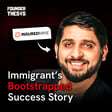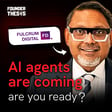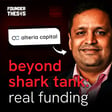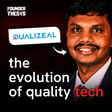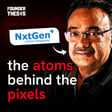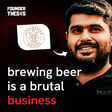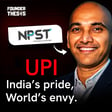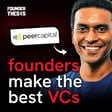Become a Creator today!Start creating today - Share your story with the world!
Start for free
00:00:00
00:00:01

Once tickled, twice ‘Oloid’ Part 2 | Mohit Garg @ Mindtickle & Oloid
Oloid is changing the game in building security. They’re revolutionizing workplace access, bidding farewell to traditional methods like pin-pads, badges, and fingerprint readers by offering a seamless single sign-on solution. Mohit shares his journey of tackling the physical access challenge in building security.
For more such interesting founder journeys, subscribe to our newsletter founderthesis.com
Read more about Oloid:-
1.This SaaS startup is modernising access control by integrating physical and digital identities
Transcript
Founding Olloid: From MindTickle to Physical Access Solutions
00:00:12
Speaker
This is a part two of a two-part episode of the founder thesis podcast in which your host Akshay Dutt interviews Mohit Garg, founder of MindTickle and Olloid. In the first part, Mohit spoke about his journey with B2B SaaS Unicorn MindTickle. Listen on to hear about Mohit's journey, building his second startup, Olloid.
00:00:31
Speaker
Oroid is also a US-focused enterprise business solving the problem of physical access in buildings. Stay tuned and subscribe to the Foundathesis podcast and any audio streaming app to learn how to build globally disruptive businesses from India.
00:00:54
Speaker
Okay.
Meeting Madhu: The Bluetooth Access Innovator
00:00:55
Speaker
Okay. So you like stop playing an operational role and became more of an advisor. Right. That's right. At that point, I had met my co-founder now, Madhu, and he and I had been friends for several years. And he was doing a very interesting startup, which
00:01:16
Speaker
he needed help with on go-to-market. So he was reaching out to me for advice. And I was so impressed with the tech stack that he had built around Bluetooth access technology as one founder with two engineers. He had 4 million downloads of his application using his Bluetooth technology.
00:01:45
Speaker
So I was... What was it? Can you describe that product? Yeah, so he had built a product for making hotel room access wireless. So as opposed to using key cards, when you go to a hotel, he had developed an SDK, which went into the mobile app of Taj. And you go to a Taj hotel, like many of us experiences in Marriott, you can directly go to your room and you don't have to go to the front desk. So huge amounts of operational efficiency, huge amounts of user experience improvements.
00:02:15
Speaker
And I was very impressed with the technology that he had built. And I could personally connect with the promise of frictionless access to buildings and physical spaces. Hotel market was a tough market to sell into. And he was struggling just in terms of how they would treat vendors and not provide the right kind of rewards for his efforts.
Strategic Pivot: From Hotels to Enterprise Markets
00:02:42
Speaker
And while I was advising him on GoToMarket, I kept on telling him that there's a much bigger play in enterprise. There's a much bigger play in the office space. There is so much automation that's starting to happen with co-working spaces and coming off the modern mobile smartphones. Companies are giving their own phones and devices, digital identity in terms of username, passwords. It's becoming more single sign-on.
00:03:13
Speaker
I did believe that you have to build a different company, whether you build it for consumer or for enterprise, it's not the same company. So he said enterprise is interesting, but I don't know enterprise and I knew enterprise. That's where I come from.
00:03:29
Speaker
agreed that if you want to do it together, we do it completely fresh. So he brought his technology stack and technology prowess with him. And we started afresh as co-founders.
Building Olloid: Integrating Digital and Physical Identity
00:03:45
Speaker
I discussed this with one of my friends, who was my classmate at Stanford 20 years back.
00:03:52
Speaker
And he also came in as a co-founder to lead engineering. My co-founder Madhu took the CTO role. And we founded Aloid to be the single sign-on for physical identity. So what that means by simply is we have
00:04:10
Speaker
G Suite username password gives us access to drive, email, spreadsheets, and whatnot. Have a similar concept for physical workspaces. So whether it's door, turnstiles, time clocks, the same physical identity should give you access to all the resources and infrastructure. So just think about there's so many manual processes we're waiting in queues to.
00:04:32
Speaker
to get services in a workplace or in a building, which can be automated. And smartphone is pervasive today. We got super excited about it. In fact, the company name that we coined all the way, it is online linked offline identity.
00:04:49
Speaker
So I have my online identity username password. So we talk about, when we talk to customers say, how cool would it be if I could use open this door with my G Suite username password? You actually can do that with a technology stack, right? So it's your taking the online concept of seamless username, passwordless access and taking that to the physical world that we got excited about. So what was the MVP?
First Product Launch: Facial Recognition in Factories
00:05:15
Speaker
I can understand from the,
00:05:19
Speaker
The user who's accessing for him, it's like an SDK which can get integrated into a mobile app, like say a Marriott app could have that as you gave an example. But what about from the enterprise side, like say on Marriott side, what would they need to do or on a company side, what would they need to do to enable this? Interestingly, our first product was not a Bluetooth or mobile access product. It ended up being a facial recognition based product.
00:05:48
Speaker
So our MVP came from huge pain point in factories around use of badges where workers would come in at 9 a.m. and they would bring their buddy's guard with them. They swipe there. That's why the buddy starts clocking hours and the buddy shows up at noon.
00:06:10
Speaker
earned three hours of fraudulent payroll. And a largest customer now got 44,000 employees. When they did the math, there was more than $2 million of estimated fraudulent payroll every year.
00:06:25
Speaker
So when we talked about digital identity and we shared our ideas with them, they said there is a strong security component there that we're not highlighting. So it's not just convenience, right? So when we came from the hotel visitor experience, this is where I believe consumer and enterprise are different, right? We over index on just the convenience part in our consumer life.
00:06:48
Speaker
enterprises need to see business value in terms of savings or revenue generation. And we could hear customers with large hourly workforce articulate this pain point consistently. So our first product was a tablet-based facial recognition product. We call it a smart reader.
00:07:07
Speaker
which turns any tablet, download the all-way DAP and the smart reader now becomes an authentication device. You can mount it on a door, you can mount it on a turnstile and it will accurately identify the person. You can't hack it by putting a picture in front of it or playing a video on your phone because many of the technologies that were existing had the promise of facial recognition but they were easily hackable.
00:07:31
Speaker
So we built a very robust product based on the iPad platform using the iPad hardware. And then we started deploying this in factories in North America. We started with California factories, then we deployed in factories in the entire US, then we deployed in Mexico and Canada.
00:07:53
Speaker
So, our initial what we call as Anchor customer design partner was a very large Fortune 500 manufacturing company. That's what I guess the paper hour, I mean, where you have a lot of paper hour jobs is where this makes sense, where the savings can be. Yeah, we talked about mobile technology and they said, you know, in our factories, when our workers come in, we ask them to put the phone in a locker and then enter the factory.
00:08:21
Speaker
They're doing manufacturing for the government, they're doing manufacturing for high IP products. People can take pictures and IP can get compromised. So there's no mobile device on the floor. We recognize that we have a very interesting problem statement. It aligns with our notion of digital identity.
00:08:41
Speaker
mobile sign-on for digital identity. We are single sign-on. So mobile is just one of the many ways of authentication. So that's where we take a broad vision and view of the world. And we said, let's start with
00:08:53
Speaker
draw definition of how people authenticate themselves. Facial recognition is very credible for hourly worker, whereas its mobile access makes a lot of sense for the knowledge worker in the office. Okay. And I'm guessing the facial recognition technology is not something that needs to be built from scratch. It's been around for a couple of years that you would have been able to plug and play some parts of it.
00:09:16
Speaker
That's right. Yeah. So we were able to take existing algorithms, partners to build MVP pretty fast. And this is where you start discovering the heart problems. And heart problems are really good because
00:09:34
Speaker
That creates value. If we were to repackage somebody else's product and just put a skin on it, we are not delivering value. So I shared with you, we realized problems around presentation attacks, where somebody can put a picture and hack a camera. We recognized problems around what if connection goes away the iPad through this Wi-Fi connection. It should still work.
00:09:54
Speaker
We recognize problems around how many data sets can you fit in an iPad? How do you do memory optimization to make sure an iPad can have 20,000 data set and it's not even connected to the cloud? So we solved some very interesting problems around integration, how data goes into a time and attendance system, data goes into a physical access control system. And that's the key thing for our listeners who think about consumer products and enterprise products. In enterprise products,
00:10:24
Speaker
People call them bells and whistles, but they are really enterprise-grade features which create value, right? Which customers appreciate and they say, yes, you are integrated with Workday, you are integrated with Chronos, you are bringing in this really pre-integrated features which make my deployment very easy. So those were areas where we continue to add value, right? It's not the facial recognition engine per se, but packaging that into a comprehensive product.
00:10:51
Speaker
Does this work with masks? There would have been that period where people would have been wearing masks. What happens then? Face masks. Yeah, so part of our selection of factories as our first go-to market, honestly, Akshay, is we built this product in COVID times and offices were not open.
00:11:17
Speaker
Whereas factories were open. So this was also a choice around
00:11:24
Speaker
responding to market realities during COVID. The reality is factories never shut down. But having said that, we found that there were clear instructions if you could provide user experience where you could prompt people to quickly pull down the mask, like it worked with it reliably. And what is the customer onboarding journey? Is it self-service for them? Because they need to give you the database of faces, right? So how does that happen?
00:11:52
Speaker
Yeah, the same tablet is also an onboarding device. So the admin can put the same tablet into onboarding mode for a new hire. So they walk the new hire, take them to the tablet and say, I put that into onboarding mode, take that picture, they put in their worker ID and get smashed and it goes into our system. It's a very easy onboarding.
00:12:11
Speaker
Yeah, onboarding is an area where I think, you know, if you think about KYC onboarding into even B2C apps, today, cell phone boarding is becoming very, very competent. It's the same thing with a product, right? We see a world where a new hire can use their own smartphone, take a selfie, do ID verification, gets onboarded into our system.
Business Growth: Subscription Model and Funding
00:12:33
Speaker
So this was product one and you know, I guess 2020 is you were selling this product, the facial recognition access control. Okay. And how does it do? What kind of revenues were you seeing from it? How do you price this? Yeah, so it's a subscription model.
00:12:50
Speaker
based on number of employees, we do multi-year contracts. So it ends up being based on number of locations, number of employees, and then you do enterprise license quickly got to half a million in ARR with this product. And that's where we raised a round of funding. We raised a lot of funding, pitching the entire vision of not just hourly workers, but also office workers. So just to explain what I'm saying is,
00:13:20
Speaker
If you bring a phone to a door, your phone has Bluetooth, the door locks don't have Bluetooth, right?
00:13:29
Speaker
And a big problem statement for any kind of disruption is how easy can you make for your customers to adopt the technology. So we had this concept for which we had already applied a patent for, which is called retrofit mobile access. Because so far in the physical identity and access industry, nobody has ever created a self-installed product. It is all professional installation.
00:13:57
Speaker
an electrician type of train person union labor will come in and pull wires and put hardware. We said we have the ability to self upgrade and self install an existing door or turnstile and the customer can place the device on their existing hardware and it would retrofit it and make it Bluetooth compatible.
00:14:22
Speaker
So that's the product we started building after our funding. It is called mTag Mobile Black. It's the first time I built hardware in my life as a founder. I've always been in software, but this felt like it's a marketing enabler. So we don't see ourselves as a hardware company. We see ourselves as a SaaS company.
00:14:44
Speaker
So we built a prototype of hardware, first in the world, a battery power device, which snaps on an existing badge reader. So when we go to offices, we swipe our card on these black devices, which sit on the wall, it's called a badge reader.
00:15:00
Speaker
So we've built a universal adapter where you can put our hardware on top of that bias reader. It snaps on. And once it snaps on, it is able to communicate with the end user's mobile device over Bluetooth.
00:15:15
Speaker
And once that communication is established, it relays the badge ID to that underlying old badge reader as if you swipe your card. So actually you're using a phone, but it's emulating the action as if you swipe your card, right? Makes it totally frictionless, makes it very easy deployment, makes it universally usable.
00:15:36
Speaker
So we built that prototype, we installed it. So how does the badge reader technology work? In what way does the badge communicate to the badge reader that this is my number? Yeah. So the badge has an antenna and when you go take your badge towards the badge reader, that antenna gets excited and the electromagnetic energy energizes the hardware in your badge.
00:16:05
Speaker
It then transmits a set of numbers in an encrypted manner over radio frequency. It's called RF technology. So this badge then sends it over the radio frequency to the badge reader. The badge reader receives it and it decodes that unique ID of that badge, sends it to a backend system and the backend system says, yes, this badge ID belongs to Akshay and Akshay has access to this door, open the door.
00:16:35
Speaker
So the hardware you built, I'll just ask this question, then you go for your test. The hardware you built, how did it know what is the encrypted message it needs to send to the badge reader? Because you're saying that there is an encrypted set of numbers being sent to the reader from the badge. How did your hardware figure out that this is the encrypted set of numbers I need to send?
00:16:57
Speaker
Yeah, so this is where integrations come into play auction. So in enterprise, all of this data, it's managed in a backend system called access control system. So if you are a new employee who joined an organization, then your badge ID, it is the resident in a backend system for access control system.
00:17:16
Speaker
So we built integration with everybody from Lenell to Honeywell to Johnson Controls. And we had the ability to pull this data. If you're a new employee who got added to the system, we automatically, Onuit Cloud was able to sync that data. Now I know Akshay has been assigned this badge ID. Now I know I can send it over to Akshay's mobile app. Now I know this can be transmitted over Bluetooth to the badge reader.
00:17:44
Speaker
So Hariwel had to agree to work with you for this because in a way it would be like hacking their system, right? They could put in place restrictions so that you don't, I mean at least they actively cooperate with you because in a way you are hacking their system, right?
00:18:05
Speaker
Yeah, I won't call it hacking your system. What I would say is it is synergistic at multiple levels. So these access control systems, they are on premise, very hard to integrate
Innovation and Integration: Legacy System Upgrades
00:18:18
Speaker
with. And customers are demanding integrations without all the word.
00:18:23
Speaker
It is hard for a customer to make their Honeywell access control system sync with workday, sync with Active Directory. From a customer standpoint, they have two choices. They could say, hey, I've had this Linux system or Honeywell or Johnson control systems for 20 years. It doesn't have the latest features or integrations. I'm going to get rid of it and replace it with something totally new and modern.
00:18:47
Speaker
Or they have a choice of, I keep my existing investments, put all of it on top, and then it becomes a full, complete solution. I don't have to depend on the place. So obviously it's very cost effective for the customer, but from Honeywell or Johnson Control, you're securing your customer base through a partnership.
00:19:03
Speaker
Amazing. So that was your solution to integrating with the existing enterprise tech or enterprise stack. So you can just build on top of that. So what has been your go-to-market for both of these products? Yeah, so our markets are large employers of hourly customers and workplaces and the workplaces are serving knowledge workers.
00:19:33
Speaker
Knowledge workers use our mobile solution, and Audi workers use our facial recognition solution. So for our mobile solution, we have partnered with channels and system integrators. Every industry has a certain industry structure. And if you look at physical identity access, building management facilities, they are very deeply entrenched players whose systems are
Market Penetration: Partnerships and Sales Strategies
00:20:02
Speaker
very hard to replace. We are not in the replacement game, we are in the augmentation game. So we are constantly increasing our set of integrations on the technology side and GTM partnerships on the channel side.
00:20:16
Speaker
So we continue to push for all the building use cases, almost exclusively through channel. For the large enterprise hourly worker use case, it's more of a CIO, CISO cell, top-down selling.
00:20:34
Speaker
more of an account-based motion, where we have set of top 50 manufacturers in the US. We're looking at additional verticals adding this year. And we are going direct. We are going direct, very similar to how we had drilled the enterprise sales motion at Mindticle. The vice president of sales at Mindticle actually joined me to help me build this out.
00:20:57
Speaker
the head of solutions consulting at Mindticle. He had joined another company and he came over to help build out the solutions consulting practice. So it's still a small team where we have more than a decade experience of working together and building enterprise go-to-market. So I shared with you that we had a large manufacturing customer who was our initial design partner.
00:21:22
Speaker
there are 44,000 workers right now we recently brought on a 110,000 employee food manufacturing company as a customer right so each of these deals end up being seven figures plus and you know require several months of committed effort of working and partnering with the customer it's a very high touch sales which i enjoy building
00:21:46
Speaker
Okay, interesting. The mobile access product, what kind of partners are these? Like these are like civil contractors or like people in the civil engineering field who would help in building fit outs and all who would kind of recommend your product to buildings.
00:22:07
Speaker
So our market is existing buildings, not new installations. So we're not going after new buildings. Existing buildings have existing batch infrastructure. So they have the backend access control systems, they have wiring and whatnot. So there are companies called system integrators who manage this on an annual contract.
00:22:31
Speaker
So these are not civil companies, right? They are certified installers and technicians. And many of these roll up into working with a large vendor like Honeywell, right? There'll be, I'm part of the Honeywell ecosystem, I'm part of the Lenel ecosystem or Johnson Controls ecosystem, right? So you're not going to individual installers, we are going to the large
00:22:57
Speaker
you know, players in this, and then we're forging partnerships at that level. And once we forge a partnership with Honeywell, as an example, we get access to their 200 regional distributors and installers. Okay. So you said this device was battery powered. Does that battery, is it like a chargeable device or it has like the Petzl cell which you can just replace or?
00:23:22
Speaker
Yeah. So today this comes with a two to three year battery life, which is self-replaceable. So it is a standard battery that can be replaced by the customer themselves. We are on version one of our product. In fact, in terms of timeline chronology, we had built the prototype was with a few beta customers. Then we raised the series A.
00:23:46
Speaker
And part of the use of the funds was to productize it, right? Go from sub-scale lab-manufactured devices for prototypes into large-scale contract-manufactured devices. So we have launched the version one of our production-level hardware.
00:24:06
Speaker
version 2 is in the works which will support many capabilities like supporting the Apple wallet also energy hardness battery where you don't have to replace the battery so yeah form factor improvements so there's a very interesting roadmap we are pursuing around the version 2 of the product
00:24:26
Speaker
Okay, so what is an energy harnessed battery? So where when you mounted on a badge reader, it is constantly getting charged through electromagnetic rays. The user, the employee, they need to have an Olloid app for the Bluetooth to work or how does it happen for them?
00:24:45
Speaker
Yeah, so today they do require an Olloid app. We have the ability to provide an SDK. So if the company had their own app, or if they were using, let's say, a visitor management app, this could be embedded inside it. We're also planning to support wallets. So once the wallet support is there, I don't
00:25:03
Speaker
I need an app. My Apple Wallet could be the key to my door for mobile access. My Samsung Wallet or Google Wallet. It would be a very similar experience to how we do mobile payments with our Apple Watch. We don't need an app for that. That's the direction in which the industry is going and we are going as well.
00:25:21
Speaker
for this device you could like directly be selling to say V-work kind of businesses which are in the like co-working space. Yeah we've already installed this product in co-working spaces. I think V-work obviously would be one of our
00:25:41
Speaker
priced prospects because of their scale and footprint. It has huge benefit for single tenant buildings. I think wherever there is commonly accessed infrastructure,
00:25:57
Speaker
Issuing badges is a big pain point. I have one badge for the elevator, one badge for the turnstile at the entry, and then I have one for my office. And then add to it, I have three offices, and I'm shuttling between offices. It's a big pain point, providing digital mobile access, alleviates a lot of those user experience points, in addition to the backend data. Just think about it. If I want to do
00:26:20
Speaker
occupancy assessment of my three buildings, which is very important these days. How many people are actually coming to the office? Pulling this data from an old on-premise system is very hard. I have to do Excel downloads from a Windows server. So there's a lot of backend modernization benefits, not just, like you said, removing the friction for the user.
00:26:41
Speaker
So you could actually help companies to design better workspaces because they will be able to run some analytics on what are the most used spaces in a building or what days do most people come in and stuff like that.
00:26:57
Speaker
So would this also work as a visitor management? Is that on your roadmap? Every time you go to a corporate office, especially in India, those DLF buildings are going down. So we already integrate with visitor management systems. We're not in the visitor management space. We don't build that application for our customers. But if our customer has an Envoy or a Veris or a signed visitor management system,
00:27:23
Speaker
Then we integrate with those. Person can go to a building, use various to fill out their form on a tablet. It will create temporary badge ID credentials, which can be downloaded on the phone.
00:27:39
Speaker
Do you also see opportunity in the apartment tech space, you know, like there are these companies like say MyGate. Geo also, Reliance also has something called GeoGate and so on, which again help in visitor management, access control for the residents and so on.
00:27:56
Speaker
So from a technology stack standpoint, the answer is yes. This does extend itself into large managed apartment home communities. In fact, fewer competitors already serve commercial and they also serve residential. From a go-to-market standpoint, you know, I am a big fan of Focus, at least in the early years.
00:28:19
Speaker
The buyers buying process ends up being very different. The pitch ends up being very different compared to the enterprise. We have built deep enterprise integrations. We have more integrations than any of our equivalent or comparable computing products. So we want to play to our strengths. So there's 72 million doors just in North America.
00:28:42
Speaker
right in the commercial real estate. So we've not even tapped into single digit percentages. Right now we see ourselves focusing almost exclusively on the workplace and enterprise and winning and becoming a very clear leader in that market.
00:29:00
Speaker
Give me some estimation of your earnings. What do you expect to close this year at? We have grown by 300% last year. We're going to grow by the same measure this year. So we're going to be like a 5 million year company in the coming year.
00:29:20
Speaker
What's on the roadmap for Olloid?
Future Visions: Biometric Identity Collaboration
00:29:22
Speaker
Would you look at merging of physical, digital access and, you know, like, eliminating passwords? Like, I've been reading for the last 10 years about different companies who want to eliminate passwords. Is that on your roadmap also? Yeah, that's happening already, Akshay. So Okta Ventures is an investor in Olloid. With them, we have been working on
00:29:49
Speaker
a joint solution where any Okta customer can bring Onoid into their mix just like Honeywell drinks in its add-on and with the Okta
00:30:03
Speaker
employees who already have their face onboarded into our system can not only use it at the door, but they can also use it to sign in to Okta. With biometric identity, you can actually create user name less and password less. So it's a level further in terms of the ease of use.
00:30:25
Speaker
Our target market is as I shared with you large employers of hourly workforce, but they don't have smartphones. So today there are really good solutions for passwordless using the mobile device.
00:30:39
Speaker
hourly workers, factory workers, they don't have the luxury of having data or a device handy or a company-provided device. Fascinating. And that brings us to the end of this conversation. I want to ask you for a favor now. Did you like listening to this show? I'd love to hear your feedback about it. Do you have your own startup ideas? I'd love to hear them.
00:31:00
Speaker
Do you have questions for any of the guests that you heard about in this show? I'd love to get your questions and pass them on to the guests. Write to me at ad at the podium dot in. That's ad at t-h-e-p-o-d-i-u-m dot in.
